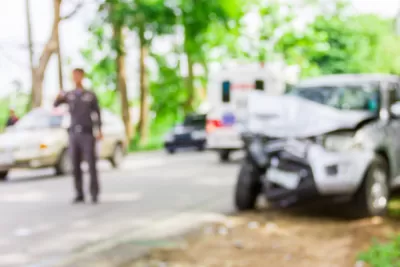After several years of increasing traffic fatalities, the total numbers of people killed by cars every year in the United States is finally declining. The same can't be said for pedestrians and people on bikes.

The National Highway Traffic Safety Administration (NHTSA) released new traffic safety data for 2018, crediting a decline in traffic fatalities to new crash prevention technologies.
Traffic fatalities declined 2.4 percent in 2018, to 36,560 people killed. So far in 2019, traffic fatalities have declined by 3.4 percent.
The new for everyone but drivers was decidedly less positive, however. Pedestrian deaths increased by 3.4 percent, there was also a 6.3 percent increase in the number of people killed while riding bicycles or other pedaled vehicles.
A statement released by the National Highway Traffic Safety Administration (NHTSA) to announce the new data, with soundbites from U.S. Department of Transportation Secretary Elaine Chao, seems more than comfortable with implying that most pedestrian and bike deaths are the fault of the victim. Here's a sample of the findings shared in the release:
- Pedestrian fatalities occurred overwhelmingly after dark (76 percent), when many pedestrians had some alcohol in their systems (38 percent), and were not at intersections (74 percent; i.e., crossing in the middle of a street or road).
- Pedalcyclist fatalities often occurred after dark (50 percent of the time), with some alcohol in their systems (26 percent), and outside of intersections (60 percent).
The press release also insists the federal government is taking action to address rising fatalities for pedestrians and people on bikes, as listed in the release:
- NHTSA is examining current and planned research related to these vulnerable road users, including recently announced plans for upgrades to the New Car Assessment Program – the 5-Star Ratings system for new vehicles. As part of these NCAP upgrades, NHTSA will consider new technologies tied to the safety of pedestrians and bicyclists, among other vulnerable road users.
- The Federal Highway Administration is working to reduce fatalities with the Bicycle and Pedestrian Program, which promotes safe, comfortable, and convenient walking and bicycling for people of all ages and abilities.
- FHWA also is focused on pedestrian and bicycle transportation through funding, policy guidance, program management, and resource development, and the availability of an FHWA Bicycle and Pedestrian Coordinator point of contact in each of its division offices.
FULL STORY: U.S. Transportation Secretary Elaine L. Chao Announces Further Decreases in Roadway Fatalities

Planetizen Federal Action Tracker
A weekly monitor of how Trump’s orders and actions are impacting planners and planning in America.

Maui's Vacation Rental Debate Turns Ugly
Verbal attacks, misinformation campaigns and fistfights plague a high-stakes debate to convert thousands of vacation rentals into long-term housing.

San Francisco Suspends Traffic Calming Amidst Record Deaths
Citing “a challenging fiscal landscape,” the city will cease the program on the heels of 42 traffic deaths, including 24 pedestrians.

Amtrak Rolls Out New Orleans to Alabama “Mardi Gras” Train
The new service will operate morning and evening departures between Mobile and New Orleans.

The Subversive Car-Free Guide to Trump's Great American Road Trip
Car-free ways to access Chicagoland’s best tourist attractions.

San Antonio and Austin are Fusing Into one Massive Megaregion
The region spanning the two central Texas cities is growing fast, posing challenges for local infrastructure and water supplies.
Urban Design for Planners 1: Software Tools
This six-course series explores essential urban design concepts using open source software and equips planners with the tools they need to participate fully in the urban design process.
Planning for Universal Design
Learn the tools for implementing Universal Design in planning regulations.
Heyer Gruel & Associates PA
JM Goldson LLC
Custer County Colorado
City of Camden Redevelopment Agency
City of Astoria
Transportation Research & Education Center (TREC) at Portland State University
Jefferson Parish Government
Camden Redevelopment Agency
City of Claremont





























